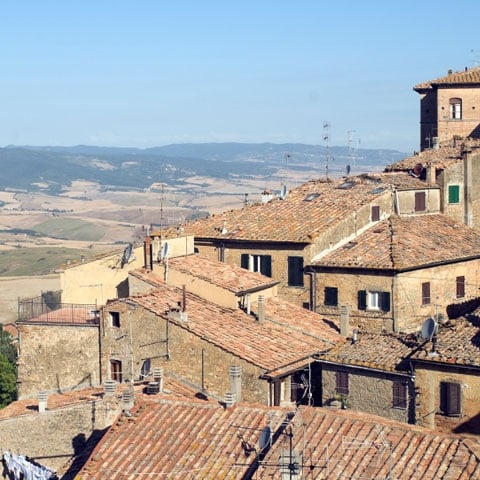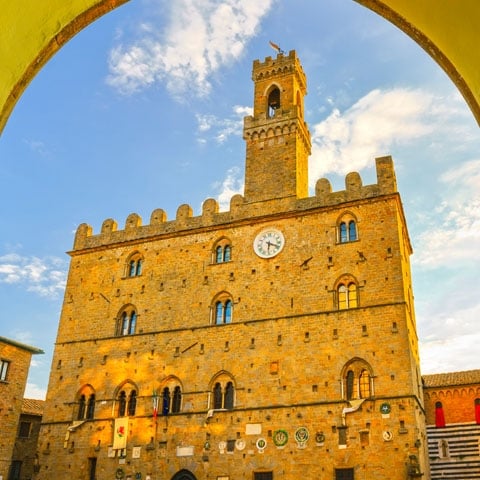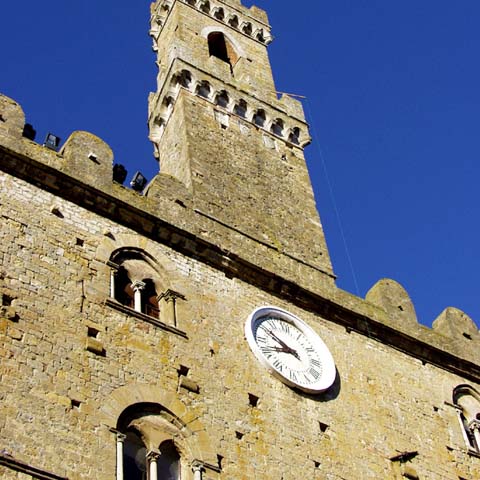Located along the Cecina River, the hilltop town of Volterra is considered to be one of the oldest continuously-inhabited settlements on the Italian peninsula. The historic center of town is of Etruscan origins and preserves fragments of Etruscan and Roman monuments. There is also a significant amount of architecture that dates back to the Middle Ages, making a trip to Volterra akin to taking a step back in time.
Still surrounded by the defensive walls first raised by the Etruscans, Volterra has been renowned for its alabaster production for centuries. In addition to the historic sites and religious points of interest, such as the Duomo of Santa Maria Assunta, visitors should make a point to visit the Museo Etrusco Guarnacci, which is considered to be one of the most extensive museums concerning the Etruscan civilization in Italy. Today, Volterra attracts international travelers thanks to its millenary history and the picturesque beauty of the surrounding countryside.
PREHISTORY OF VOLTERRA
There is evidence that the territory of Volterra was already inhabited as early as the first Iron Age.
Around the end of the eighth century BC, markets and areas of worship began to be held on the surrounding hills. Archaeological excavations conducted in 1896 have brought to light an archaic necropolis with about thirty tombs, some for cremation, others for inhumation, dating back to the seventh century BC and earlier.
Volterra was one of the 12 lucumonies, the most important cities for the Etruscan people. In fact, it was the Etruscans who founded the city of Velathri during the fourth century BC. The town incorporated all of the settlements that had been created on the hill since the Neolithic Period.
The Etruscans also constructed a long wall of approximately 5,900 feet to defend the acropolis. Over time, the wall was enlarged, so that it could defend the settlement against the looting of the Gauls and Ligurians.
Before falling under Rome, the town experienced a period of economic expansion and social stability.
The privileged position in the hills combined with the walls protected the town from invasions. Agriculture flourished and the production of timber and grain was abundant. The presence of copper, silver mines, and alabaster quarries provided precious raw materials. Trade was also favored by the presence of waterways that served as natural communication routes. It is believed that the boraciferous fumaroles of the Cecina valleys were already utilized at that time.
The prosperity of local trade is also attested to by the bronze coins that were put into circulation in the middle of the third century BC.
The aristocracy that administered the city guaranteed a certain independence to the citizens.
During the third century BC, Volterra was one of the last Etruscan cities to fall under the dominion of Rome and took the name of Volaterrae.
The first written documents that mention Volterra refer to the war against the King of Rome Lucius Tarquinius Priscus.
Volterra supported Rome and contributed — mainly by supplying grain and ships — to the Second Punic War fought between Rome and Carthage from 218 BC to 202 BC. The war began on the initiative of the Carthaginians, who intended to recover the military power and political influence lost after the defeat suffered in the First Punic War.
Contrary to the First Punic War, which was fought and won essentially at sea, the second war was characterized above all by great land battles, with movements of enormous masses of infantry, elephants, and knights.
Loyalty to Rome was rewarded and in 90 BC Volterra obtained Roman citizenship. The title of municipium guaranteed autonomy to the city and its citizens.
Civil wars followed within Rome, in particular between the consuls Marius and Sulla. The city was besieged and sacked, and its inhabitants lost their citizenship.
Short periods followed in which the city seemed to regain a certain prosperity but, after the opening of the great coastal road Emilia di Scauro (114-109 BC), Volterra lost its commercial centrality and rapidly declined.
There is no news of Volterra in relation to the years of the crisis of the Roman Empire.
HISTORY OF VOLTERRA
Governed from the fifth century by the Lombards and the Franks, in the following centuries Volterra became a bishopric seat that controlled a very large territory. The bishop enjoyed imperial privileges including the ability to mint money. The bishopric remained in the hands of the powerful Pannocchieschi family for about a century.
Around 1160, episcopal power reached its peak with Galgano Pannocchieschi, who ruled on behalf of Holy Roman Emperor Frederick Barbarossa. The despotism of this bishop fostered anti-bishopric revolts, headed by the local feudal lords and exponents of the nascent municipal bourgeoisie.
Towards the end of the 1100s and the beginning of the 1200s, the bishops definitively lost their power. As a result, the municipality gained more and more autonomy, and in 1208 the construction of the Palazzo dei Priori, the symbol and seat of municipal power, began.
A brief imperial dominion was established under Frederick II (1245-50), but the internal contrasts offered the opportunity to powerful neighboring municipalities (namely, Florence, Siena, and Pisa) to extend their dominion in the Volterra area. Subsequently, Florence settled a Florentine podestà in Volterra after a victory in 1254.
Between the thirteenth and fourteenth centuries, struggles between the Guelphs and Ghibellines also flared up in Volterra, where the two factions were led by the Belforti and Allegretti families, respectively.
In 1340, Lord Ottaviano Belforti, a Guelph, took office. Octaviano’s successor was his son Bocchino, who ruled like a tyrant and alienated the trust of the people of Volterra, and especially of Florence. The Florentines took advantage of the strong internal conflicts and in 1361 they occupied the fortress, appointing one of their citizens as captain, excluding the Volterrani from political offices.
Volterra opposed these actions and Giusto Landini led a rebellion, though he was subsequently the victim of a conspiracy among Volterra’s nobles, who feared the consequences of a rebellion against Florence.
Florence retained control and the Volterra family feuds continued, often in a very violent way. Eventually, the Duke of Urbino Federico da Montefeltro’s army invaded the city to restore order. The noble tower houses were destroyed and a main tower, a symbol of Florentine power, was built.
Volterra sided with the Medici against the Spanish troops.
After the final return of the Medici to Florence, Volterra followed the events of the nascent Grand Duchy of Tuscany.
The seventeenth century was a period marked by plague epidemics, famines, droughts, and economic crises. This caused a strong demographic decline in Volterra, as in all of Tuscany.
During the eighteenth century, thanks to the processing of alabaster and its market, Volterra made a slight recovery.
In 1796, the city was occupied by French troops and remained a Napoleonic territory until 1814, when the Habsburg-Lorraine of Tuscany returned to power.
Once more, the city grew from an economic, social, and, consequently, demographic point of view.
In 1860, nearly the entire population was in favor of the annexation to the Kingdom of Italy.
In 1912, the Saline-Volterra railway line was inaugurated.
Volterra followed the fate of the Italian peninsula in the events of the two world wars. During World War II, Volterra distinguished itself for its active anti-fascist participation.
Today, Volterra is known for its Etruscan history, alabaster production, and vast natural landscapes that are emblematic of Tuscany’s tranquility.
ARCHAEOLOGY IN VOLTERRA
The Guarnacci Etruscan Museum was founded in 1761 when Mario Guarnacci donated his vast archaeological collection to the city of Volterra. It is one of the oldest public museums in Europe. The museum presents pre- and protohistoric, archaic, and classical monuments, as well as finds dating back to the end of the fourth to the first century BC.
At the museum, visitors can admire reconstructions of the necropolis of the ninth to eighth century BC found in the territory. Also of interest is the Stele of Avile Tite, a funerary monument depicting a warrior armed with a spear and sword that shows close affinity with Greek-oriental works.
Cinerary urns, which held cremation remains, were typical of Volterra and the surrounding area. These were housed in the family tomb where relatives would place objects to be used in the afterlife.
There is no shortage of ancient tools for working alabaster, as well as many bronze objects, another material widely present in the area since ancient times. These include mirrors, votive statuettes, pottery, coins produced by the local mint, and ceramics.
One of the most significant objects of the entire collection is the first century BC terracotta lid of the spouses, which depicts two elderly spouses with strongly characterized faces lying on a banquet bed.
The museum also houses very rare Etruscan coins in gold, silver, bronze, and over three thousand Greek, Roman, Republican and Imperial coins as well as gold jewelry and gems.
Finally, a section of the museum is dedicated to Roman Volterra. On display are materials from the urban area and from Vallebuona where the ancient theater is located.
The Vallebuona Archeological Area is a large space on the northern slopes of Volterra, just beyond the walls that enclosed the medieval city. The area was urbanized in Roman times with a theater and a spa built in different eras. Remains of the gallery and the steps are visible, where visitors can read the names of families from Volterra. Some rooms with marble decorations and mosaics have been preserved. At the end of the second century AD, the theater underwent some minor interventions, but it definitively ceased its activity towards the end of the third century, probably due to an earthquake that caused part of the structure to collapse.















